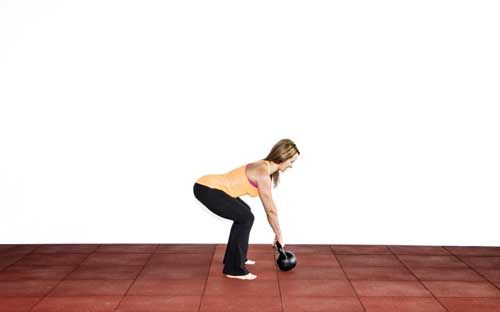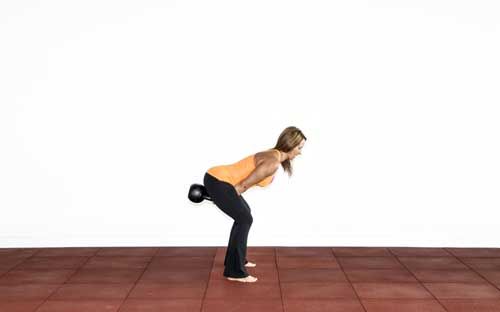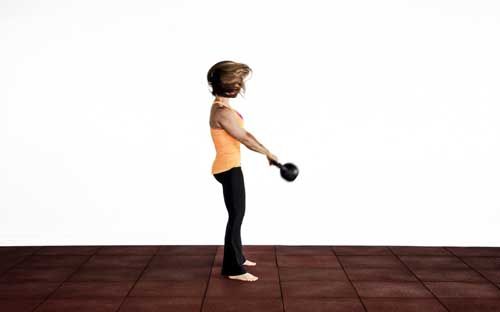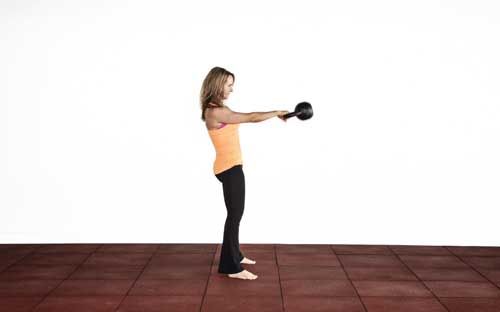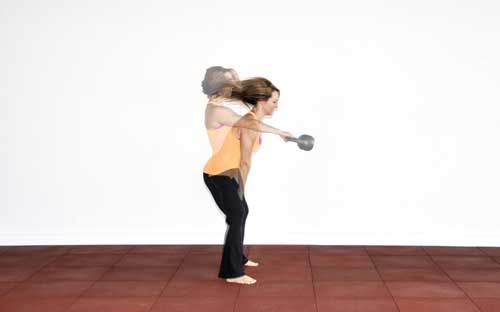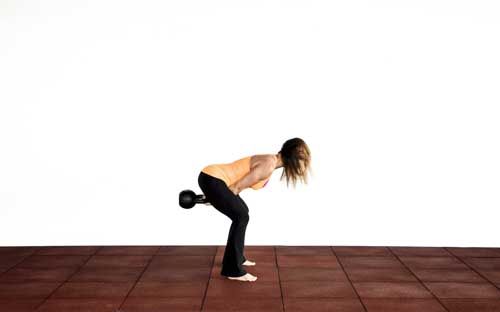Here’s a secret: the swing has almost nothing to do with the kettlebell. It’s all about your hips.
Think of it this way: if I took the kettlebell away, the movement would still be the same. You’re reaching your hips back, then explosively driving them forward while keeping your spine strong and your arms connected to your torso. The kettlebell just amplifies the training effect, forcing you to produce more power, work harder, stabilize, neutralize and get more done in less time.
Many of the world’s best trainers, athletes, and fitness enthusiasts love kettlebell swings. Here’s why:
-
Full-body efficiency: Strength, power, endurance, and cardio in one move.
-
Posture fixing: Lifestyle antidote for too much slouching, sitting, and “text neck.”
-
Back-saving mechanics: Teaches you to move from your hips, not your spine.
-
Real-world strength: Makes lifting, carrying, and playing easier.
-
Massive fun: Pure exhilarating, heart pounding, results driving enjoyment.
If you want safer mechanics for picking up your kids, more power to hoist heavy suitcases, and endurance to play longer with less fatigue, swings have your back.
To get the most out of this beautifully simple move, you need to execute it well. Ugly swings lead to all kinds of trouble. That means:
To swing well, you need three key skills:
Your hips and back need to move independently. Hinging is a fundamental movement pattern that many people lose due to poor posture. Here’s how to reclaim it:
- Keep your spine neutral and core braced.
- Push your glutes back as far as you can while keeping your shins vertical.
- Drive your feet into the floor to stand tall.
Bracing isn’t “sucking in your belly.” It’s creating a 360-degree shield around your spine to restrict all unwanted movement. Think like a boxer ready to take a punch to the midsection. Or the core contraction you get when you exhale all of your air out.
Your arms shouldn’t dangle like loose ropes. Instead, actively pull your arm bones into their sockets, retract your shoulder blades, and keep your shoulders away from your ears. This keeps your back engaged and prevents energy leaks.
It's super common for students to ask "what is this working?" A well-executed swing lights up nearly every major muscle group:
-
Hike: Lats, core, hamstrings, hip flexors.
-
Snap: Glutes, quads, hamstrings, core, shoulders.
-
Lock: Full-body tension, core, posture muscles.
-
Load: Controlled eccentric strength, grip, lats, and back.
Every movement has a start, middle, and end. Most people skip the start, focus too much on the middle, and get sloppy at the end. Let’s fix that.
- Set Up – Stand about a foot behind the kettlebell. Hinge at the hips, keep a neutral spine, and reach forward to grip the handle. Shoulders above hips, hips above knees. Shins (near) vertical.
- Hike – Like a football snap, pull the kettlebell back between your legs, keeping it high in your “leg triangle.” Your lats should engage to control the movement.
- Snap – Drive your feet into the ground and explosively extend your hips. The kettlebell will float up to chest level without you muscling it. Your power comes from the hips, not the arms.
- Lock – At the top, your body should be a vertical plank: glutes squeezed, kneecaps pulled up (quads engaged), core braced, shoulders packed (or connected).
- Load – Let gravity pull the kettlebell down. Stay patient (we call that playing chicken with the kettlebell). Once your arm reconnect with your ribcage, hinge your hips back powerfully into another hike.
- Park – After your last rep, reverse the hike, keeping a strong spine. Set the kettlebell down exactly as you picked it up. No crashes, no collapses.
Empty space, drag to resize
Empty space, drag to resize
-
Tight hamstrings (limiting your hinge)
-
Tight hip flexors (blocking full hip extension)
-
Weak glutes (not firing properly)
-
Poor proprioception (not knowing where your body is in space)
-
Lack of core stability (causing energy leaks)
-
Bad footwear (barefoot is best, zero foot drop minimalist shoes is next)
New swingers often run into these problems:
- Problem: Your swing lacks power, and your lower back takes a hit.
- Fix: Master the brace. Practice deadlifts and moving planks to build core control.
- Problem: You’re either treating the swing like a squat or folding in half like a “tippy bird.”
- Fix: Find a sport-ready stance. Your knees bend, but the hips lead the move.
- Problem: Your knees drive forward out of your backswing which leads to scooping, or riding the camel.
- Fix: Slightly elevate your toes or block forward shin motion with a bench or obstacle. This'll help with squatty swings too.
- Problem: Your swings feel weak, slow, or disconnected.
- Fix: Try hip hinges with a resistance band pulling you backward, or practice broad jumps to develop explosive hip drive.
- Problem: The kettlebell swings too far forward or too low between your legs, pulling you off balance.
- Fix: Work on shoulder retraction drills and practice swings with a towel looped through the handle to feel the difference. During the backswing, keep kettlebell handle above your knees.
A crisp, powerful kettlebell swing isn’t just a cool party trick—it’s a movement that strengthens you for life. If your goal is to move better, feel stronger, and train smarter, the swing delivers. Dial in your technique, focus on quality over quantity, and feel the difference in every rep.
Now, grab a kettlebell, set up strong, and let’s get to work.
Empty space, drag to resize
My 101 Swing Finisher Video Series is available now! Circuits, intervals, dash races, oddball reps and more to keep things fun and your fitness grooving.

